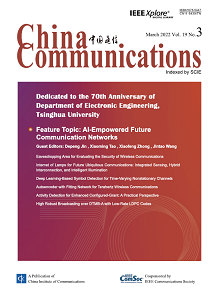6G TOWARDS 2030: FROM KEY TECHNOLOGY TO NETWORK ARCHITECTURE
Mengting Lou, Jing Jin, Hanning Wang, Dan Wu, Liang Xia, Qixing Wang, Yifei Yuan, Jiangzhou Wang
2022, 19(3): 88-100.
Massive multiple-input multiple-output (MIMO) technology enables higher data rate transmission in the future mobile communications. However, exploiting a large number of antenna elements at base station (BS) makes effective implementation of massive MIMO challenging, due to the size and weight limits of the masssive MIMO that are located on each BS. Therefore, in order to miniaturize the massive MIMO, it is crucial to reduce the number of antenna elements via effective methods such as sparse array synthesis. In this paper, a multiple-pattern synthesis is considered towards convex optimization (CO). The joint convex optimization (JCO) based synthesis is proposed to construct a codebook for beamforming. Then, a criterion containing multiple constraints is developed, in which the sparse array is required to fullfill all constraints. Finally, extensive evaluations are performed under realistic simulation settings. The results show that with the same number of antenna elements, sparse array using the proposed JCO-based synthesis outperforms not only the uniform array, but also the sparse array with the existing CO-based synthesis method. Furthermore, with a half of the number of antenna elements that on the uniform array, the performance of the JCO-based sparse array approaches to that of the uniform array.
